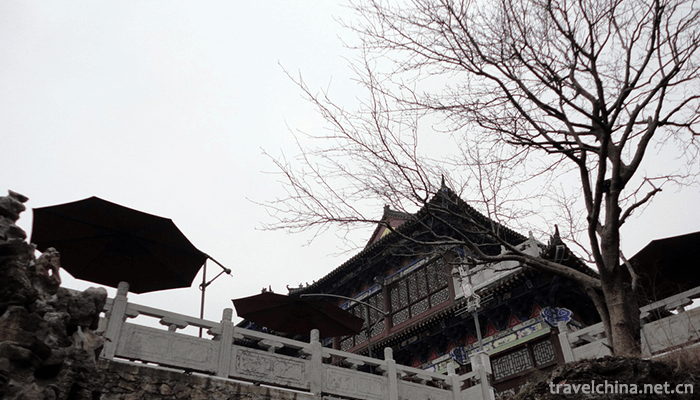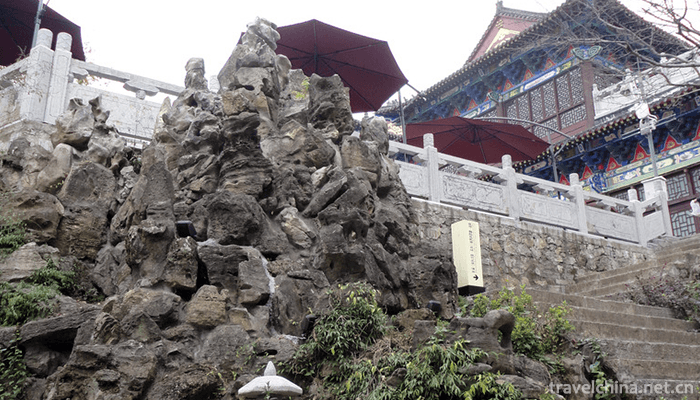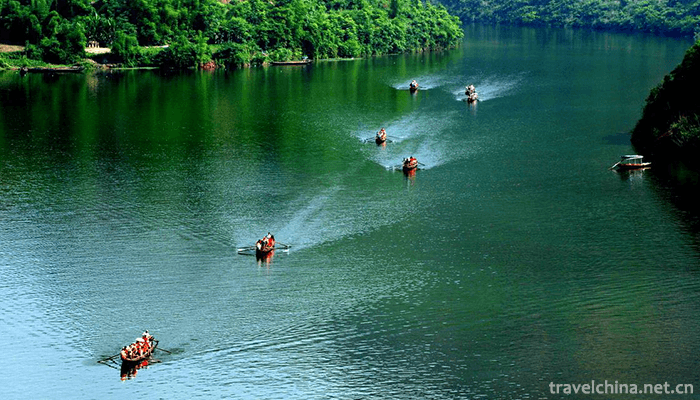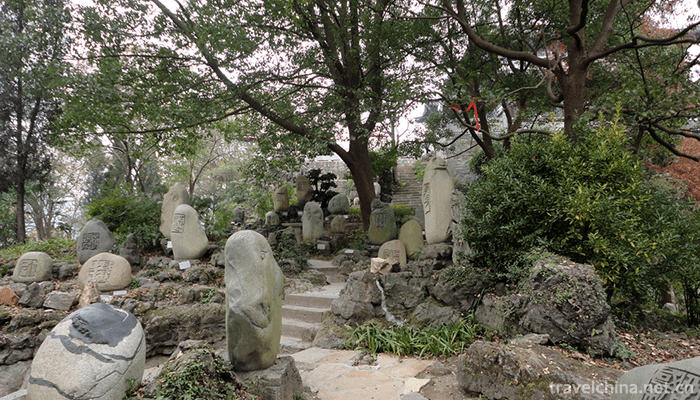The Three Tours Cave Scenic Area is located outside Xiling Gorge, about 10 kilometers away from Yichang. There are two allusions to the name of Sanyou Cave. The Tang poets Bai Juyi, Bai Xingjian and Yuanzhen once visited the cave together, known as "the first three tours". In the Song Dynasty, Su Xun, Su Shi and Su Zhe's father and son also visited the cave together, known as "the last three tours".
The main scenic spots in the Sanyou Cave scenic area are three tourist caves, Zhixiting, Chusailou, the ruins of the ancient military fortress, Zhang Fei's Ronggutai and Lu You Quan.
History of scenic spots
Eastern Han Dynasty
According to the Records of Three Kingdoms, Liu Bei joined Sun Quan-huo to attack Chibi in the third year of Jian'an in the Eastern Han Dynasty (A.D. 208). After defeating Cao Jun, Liu Bei went south and attacked Wuling, Changsha, Guiyang and Lingling counties, around the fifteenth year of Jian'an (A.D. 210). "First of all, he decided to fly to the south of the Yangtze River, and then he was too wary of commanding generals." Zhang Fei used to play drums at the top of Xiling Mountain and perform horses and soldiers day and night to guard the Three Gorges Gate.
Southern Dynasties
During the reign of Emperor Liang Yuandi in the reign of Chengsheng (553 A.D.), Lu Honghe built "Qishengcheng" in Xiakou. In the fifth year of Chen Taijian in the Southern Dynasty (573 A.D.), Emperor Xuandi conquered Jiangling and built "An Lu Cheng" in Xikou to prepare for Shu prisoners. There were still military fortress sites and urban ruins of the Six Dynasties on the platform of Xilingshan Xilaoxi.
The Tang Dynasty
Tang Xianzongyuan and three years (AD 808) when Bai Juyi was appointed Zuo Pick-up Officer in front of the Emperor, he offended the court eunuchs and officials because of his upright temperament. His colleague Yuanzhen was whipped by eunuch Liu Shiyuan. Tang Xianzong's Li Chun-fei did not ask Liu Shiyuan for guilt. Instead, he demoted Yuanzhen to Tongzhou (now Dachuan City, Sichuan Province). Bai Juyi had written to defend him three times. In the 10th year of the Yuan Dynasty (815 AD), he was persecuted because he wrote to the court to expose the murder of Prime Minister Wu Yuanheng. He was demoted to Sima of Jiangzhou (Jiujiang, Jiangxi Province). In the 14th year of the Yuan Dynasty (819 AD), Bai Juyi was assassinated by Sima Shengzhong of Jiangzhou (Zhongxian, Chongqing). His brother, Bai Xingjian, unexpectedly met Yuanzhen in Xilingxia Gorge when he was having a banquet. The Cave Mansion was proposed by Yuan Zhen: "It is difficult for us to meet each other, and the situation is not easy to get. Please write in 20 rhymes of ancient poems, and write in stone walls" and record it by Bai Juyi. At the end of the preface, it says "three of us first travel, so it is three travel caves". Sanyou Cave was named after Bai Juyi, a poet of Tang Dynasty, who discovered the cave.
Northern Song Dynasty
Song Qingjie, an erudite scholar in the second year of Jingyou (1035 A.D.), was appointed to Zhizhou, Xiazhou. He carried out a series of folk-custom reforms and renovation of streets and city gates in Yiling County. The transformation of grass houses into tile houses in Yichang also began in this period. Jingyou three years (1036 A.D.). Song Qingji built a pavilion in Jiangjin outside Xisaimen, Yiling, named "Best Happiness", and invited Ouyang Xiu, a writer who was demoted to Yiling in May this year to serve as county decree, to write a story of Xiazhou to Xiting for the pavilion. Huang Tingjian, a famous calligrapher in the Song Dynasty, wrote inscriptions on tablets. The pavilion was renowned by Ouyang Xiu. It was later listed as one of the three major scenic spots of Yiling. Since its establishment over 900 years ago, the Xiting has undergone a process of second relocation. In 1981, it was rebuilt in Wangxiangtai, Beifeng, Xiling Mountain.
Southern Song Dynasty
In the fifth year of Kao Zong's Qian Dao in Southern Song Dynasty (A.D. 1169), he lived with the army on October 8. When he entered Shu, he traveled through Yiling Mausoleum and was in Sanyou Cave. When Lu You saw Huang Tingjian and Ouyang Xiu's inscriptions, he was full of emotion and enjoyment. He took the water from Tanzhong Spring to fry tea. The water was very strange and the tea tasted delicious. Xiaotan leaned on the hills and rivers, and Lu You forgot to return. The inscription "The water from Yanxia Pool in front of Sanyou Cave" was waiting on the rock wall beside the pool. From then on, this unknown mountain spring was called "Lu You Spring".
Counter-Japanese War
During the Anti-Japanese War, Xialaoxi became a natural barrier to the Japanese army. Nanjin Pass on the South Bank of Xialaoxi was occupied by the Japanese army, and Chen Cheng, commander of the fifth theatre at that time, was located near it. In October 1938, Yan Lisan, acting chairman and Minister of Civil Affairs of the Hubei Provincial Government, led the provincial government officials, such as Zhang Nanguang and Shi Xie, to move to work in Sanyou Cave and preside over the provincial anti-Japanese and national salvation work.
geographical environment
The karst landform of Sanyou Cave is mainly manifested in the typical karst landscape of Sanyou Cave. In the cave, three stalactite pillars are arranged horizontally from the sky, and the three caves are naturally divided into two stone chambers. The two pendulous stalactites juxtaposed between the anterior chamber and the posterior chamber are natural, like a couplet of doors. The whole huge cave body of the Three Tours Cave is erected by many stalactite pillars, which seem to be supported by stalactite pillars. Outside the Sanyou Cave, obvious bedding structure of limestone can often be seen. In addition to dissolution, it also includes mechanical erosion processes such as erosion, submergence erosion and collapse of flowing water.
Scenic spots
There are three main scenic spots in the scenic area, namely, tourist caves, Zhixiting, Chusailou, the ruins of the ancient military fortress, Zhangfei Ronggutai, Lu Youquan and so on.
Three You-dong, three You-dong, was born on the cliff and has a trestle to pass through. The cave is about 20 meters wide, 10 meters high and 30 meters deep. There are three stalactites in the cave. Inside the cave are inscriptions of past dynasties, and on the cliff wall outside the cave are inscribed poems and essays of past generations of visitors. The suspended stone on the top of the cave is called the Tianzhong, and the convex stone on the ground is called the earth drum.
The scenery of Sanyou Cave is fantastic, which was once called "illusion" by the ancients. Most of the people who traveled through Yiling (Yichang) in the past dynasties visited this place and wrote scenery and thoughts in the forms of regular script, official script, line script, grass script, poetry, prose, murals, inscriptions and so on, engraved on the stone wall. Up to now, there are still more than 40 inscriptions and inscriptions inside and outside the cave, such as Ouyang Xiu inscriptions in Song Dynasty, Preface to Three Travels to the Cave, which were re-engraved in Ming Dynasty, leaving precious cultural and historical materials.
Xiting to Xiting was built in Song Dynasty. At that time, the writer Ouyang Xiu was demoted to Yichang County Decree. After Zhu Qing's capital was built in Xiazhou, Ouyang Xiu was entrusted to write a special note on the pavilion, that is, Xiazhou to Xiting, which made the pavilion one of the three great attractions of Xiazhou. Due to the war and other human factors, the ancient complex of Xiba Miaozui in Yichang was destroyed, and eighty words of long couplets with beautiful mats in Xiting, Xiting "plaque" and Donghu Zhixian forest were destroyed successively. The newly built red pillars on the eaves of Zhixi Pavilion, with triple eaves, glass tile surface, blue stone carved balustrade, 18 meters high, Pavilion layers, spiral stairs in the building, and dozens of ancient and modern poems and paintings by Ouyang Xiu are erected in the pavilion.
Lu Youquan, a patriotic poet of the Song Dynasty, visited three caves by way of Yiling, according to local chronicles. He found a pool of clear spring water above Xialao River. He fetched water and fried tea. The fragrance was sweet. After admiring it, he left a poem: "It is not a well-known spring that can not be tasted." This is the origin of Lu Youquan.
Xiakou Military Barrier: It was built in the Northern and Southern Dynasties and lasted until the Six Dynasties. It is also the only ancient military relic of Xiakou. Ancient arrow arrows and old bricks of the Eastern Han Dynasty were unearthed in the barrier. The ancient military barrier at Xilingxia was built to enjoy the beautiful scenery of Xilingxia Pass and feel the magnificence of the ancient Grand Pass.
Seal Stone Garden and Seal Stone Garden collected seals from 127 world-renowned Chinese painters such as Wu Zuoren, Guan Shanyue and Wang Chaowen. The core stone of the Three Gorges Dam is carefully carved. Its style is different and natural. It enlarges the seal commonly used by artists into seal stone carvings.
Three Gorges Qishi Museum, the largest one in the Three Gorges area, has collected 231 rare stones of the Three Gorges, including "lofty souls, Buddha's light, Zhaojun's fortress, Jiangshan's delicate and other exquisite stones".
Since the Tang and Song Dynasties, Bai Juyi, Yuan Zhen, Bai Xingjian, Ouyang Xiu, Su Xun, Su Shi, Su Zhi, Huang Tingjian, Lu You and other celebrities who have visited the three caves in successive dynasties, as well as officials who have served in Yiling Mausoleum, or inscribed poems or inscriptions, have made more than 100 inscriptions and inscriptions. Nearly 60 pieces have been preserved and found, including regular script, official script, seal, line and grass. Like Lu Wei of the Qing Dynasty inscribed on the wall of Li Shu, Chen Jianwai's eldest daughter, Boudois Ying, wrote in small seal letters on the wall of Occupied Palm Rock, a giant inscription of "Occupied Palm Rock is not stubborn, chemical industry has a treasure-shaped mountain, opens up chaos and reveals the key to human life and death". They can be called calligraphic works.
Tourism information
Ticket price: 78.00 yuan
Opening hours: 08:00-17:00
Scenic Shopping: There are many local and Three Gorges specialties to buy in Yichang, including citrus, kiwifruit and persimmon. Tea includes Chunmei tea, Xiazhou green tea, Jasmine spring tea, Yihong Gongfu tea, cactus tea and so on. There are also some high-quality chestnut, mushroom and agaric.
Local delicacies: Yichang's diet not only has the big meal of inland river fat fish, but also has many ethnic snacks. Its main style of dishes is "original juice, salty, spicy", with strong local characteristics. The "Lao Jiu Bowl" banquet has the local characteristics of Yichang. The dishes on the banquet consist of nine courses: miscellaneous steamed heads, fried butterflies, fried spring rolls, fish cake balls, squid bamboo shoots, hammer bowl lotus seeds, white meat belly, fungus chicken, pearl balls and so on. They are served in large bowls with strong local flavor.




0 Questions
Ask a Question
Your email address will not be published.